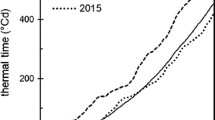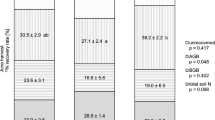Abstract
In northwestern Germany slurry injection below maize (Zea mays L.) seeds is gaining increasing interest of farmers, because of the expected enhanced nitrogen (N) and phosphorus (P) use efficiencies compared to the usual fertilizing practice. The present study aims to compare the spatial and temporal soil mineral nitrogen (SMN) dynamics for these fertilizing strategies. Field trials with four treatments (unfertilized control, broadcast application + N P mineral starter fertilizer (+MSF), injection and injection + nitrification inhibitor (NI)) were conducted using pig slurry on sandy soil in 2014 and 2015. Soil samples were taken from three soil layers at 30 cm intervals down to 90 cm, and at three positions (below the maize row, 15 and 30 cm distance to the row) at several dates over the growing season. Soil monoliths (15 × 15 × 10 cm) were sampled around the injection zone, and for all other soil zones an auger was used. In 2014 due to heavy rainfall all fertilized N was displaced from the top soil layer of the broadcast treatment until 6-leaf stage, while N displacement was significantly smaller after slurry injection (about 20 kg SMN ha−1 more in top layer). The lateral movement of injected slurry N was negligible. In 2015 almost no displacement of fertilized N out of the top soil layer occurred independently of treatments, because of lower rainfall. The release of slurry N was delayed following broadcast application and large SMN concentrations were detected in the injection zones until 10-leaf stage. The addition of a NI resulted in significantly increased ammonium N concentrations in the injection zone throughout the early growth stages [+46 % (2014) and +12 % (2015) at 6-leaf stage]. Thus, N displacement was delayed in 2014 and in 2015 at 6-leaf stage increased SMN concentrations (+1/3 with NI) were found around the slurry band. Due to slurry injection, especially when combined with a nitrification inhibitor, the applied nitrogen is located in a soil zone with better spatial availability for plant roots compared to broadcast application and the risk of nitrate leaching is significantly reduced.




Similar content being viewed by others
References
Ahmed SI, Mickelson SK, Pederson CH, Baker JL, Kanwar RS, Lorimor JC, Webber DF (2013) Swine manure rate, timing, and application method effects on post-harvest soil nutrients, crop yield, and potential water quality implications in a corn-soybean rotation. Trans ASABE 56:395–408
Amberger A (1986) Potentials of nitrification inhibitors in modern N-fertilizer management. Z Pflanz Bodenkunde 149:469–484. doi:10.1002/jpln.19861490410
Bacon PE (1995) Nitrogen fertilization in the environment. M. Dekker, New York
Baumgärtel G, Benke M, Eiler T (2010) Düngeempfehlungen Stickstoff: getreide, Raps, Hackfrüchte, Mais. Landwirtschaftskammer Niedersachsen, Hannover
Bremner JM, Keeney DR (1966) Determination and isotope-ratio analysis of different forms of nitrogen in soils: 3. Exchangeable ammonium, nitrate, and nitrite by extraction-distillation methods. Soil Sci Soc Am Pro 30:577–582. doi:10.2136/sssaj1966.03615995003000050015x
Burger M, Venterea RT (2008) Nitrogen immobilization and mineralization kinetics of cattle, hog, and turkey manure applied to soil. Soil Sci Soc Am J 72:1570–1579
Cameron KC, Andrew WR, Noonan MJ, Moore S, Smith NP, Kerr LE (1996) Lysimeter study of the fate of nutrients following subsurface injection and surface application of dairy pond sludge to pasture. Agric Ecosyst Environ 58:187–197. doi:10.1016/0167-8809(96)01029-8
Cameron KC, Di HJ, Moir JL (2013) Nitrogen losses from the soil/plant system: a review. Ann Appl Biol 162:145–173. doi:10.1111/aab.12014
Carozzi M, Ferrara RM, Rana G, Acutis M (2013) Evaluation of mitigation strategies to reduce ammonia losses from slurry fertilisation on arable lands. Sci Total Environ 449:126–133. doi:10.1016/j.scitotenv.2012.12.082
Ceretta CA, Girotto E, Lourenzi CR, Trentin G, Vieira RCB, Brunetto G (2010) Nutrient transfer by runoff under no tillage in a soil treated with successive applications of pig slurry. Agric Ecosyst Environ 139:689–699
Chen Y, Assefa B, Arkinrem, W (2010) Soil nutrient levels and crop performance at various lateral positions following liquid manure injection. Agric Eng Int CIGR EJ XII (Manuscript 1410)
Comfort SD, Kelling KA, Keeney DR, Converse JC (1988) The fate of nitrogen from injected liquid manure in a silt loam soil. J Environ Qual 4:317–322. doi:10.2134/jeq1988.00472425001700020027x
Dell CJ, Meisinger JJ, Beegle DB (2011) Subsurface application of manures slurries for conservation tillage and pasture soils and their impact on the nitrogen balance. J Environ Qual 40:352–361. doi:10.2134/jeq2010.0069
DIN EN 15476:2009-04 (2009) Düngemittel—Bestimmung von Nitrat- und Ammoniumstickstoff nach Devarda. Beuth Verlag GmbH, Berlin, Germany
DIN EN 19746:2005-06 (2005): Bodenbeschaffenheit – Bestimmung von mineralischem Stickstoff (Nitrat und Ammonium) in Bodenprofilen (Nmin-Laborverfahren). Beuth Verlag GmbH, Berlin, Germany
Dittert K, Bol R, King R, Chadwick D, Hatch D (2001) Use of a novel nitrification inhibitor to reduce nitrous oxide emission from 15 N-labelled dairy slurry injected into soil. Rapid Commun Mass SP 15:1291–1296. doi:10.1002/rcm.335
Dosch P, Gutser R (1996) Reducing N losses (NH3, N2O, N2) and immobilization from slurry through optimized application techniques. Fertil Res 43:165–171. doi:10.1007/BF00747697
Federolf C, Westerschulte M, Olfs H-W, Broll G, Trautz D (2016a) Enhanced nutrient use efficiencies from liquid manure by positioned injection in maize cropping in northwest Germany. Eur J Agron 75:130–138. doi:10.1016/j.eja.2016.01.016
Federolf C, Westerschulte M, Olfs H-W, Broll G, Trautz D (2016b) Nitrogen dynamics following slurry injection in maize—crop development. Nutr Cycl Agroecosyst Submitted (together with the present manuscript)
Grubbs FE (1950) Sample criteria for testing outlying observations. Ann Math Statist 21:27–58. doi:10.1214/aoms/1177729885
Guiraud G, Marol C, Fardeau JC (1992) Balance and immobilization of (15NH4)2SO4 in a soil after the addition of didin as a nitrification inhibitor. Biol Fertil Soils 14:23–29
Haynes RJ (1986) Mineral nitrogen in the plant-soil system. Academic Press, Orlando
IUSS Working Group WRB (2014) World Reference Base for Soil Resources. International soil classification system for naming soils and creating legends for soil maps. World Soil Reports No. 106. FAO, Rome, Italy
Kanisch G, Kirchhoff K, Michel R, Rühle H, Wiechen A (1998) Genauigkeit von Messwerten, Empfehlungen zur Dokumentation. Gustav Fischer Verlag, Ulm
Kayser M, Benke M, Isselstein J (2011) Little fertilizer response but high N loss risk of maize on a productive organic-sandy soil. Agron Sustain Dev 31:709–718. doi:10.1007/s13593-011-0046-9
Kirchmann H, Lundvall A (1993) Relationship between N immobilization and volatile fatty acids in soil after application of pig and cattle slurry. Biol Fertil Soils 15:161–164. doi:10.1007/BF00361605
Kuzyakov Y, Friedel JK, Stahr K (2000) Review of mechanisms and quantification of priming effects. Soil Biol Biochem 32:1485–1498
Lichtenegger E, Kutschera L, Sobotik M (2009) Wurzelatlas der Kulturpflanzen gemässigter Gebiete: Mit Arten des Feldgemüsebaues. DLG-Verlag, Frankfurt/Main
McCormick RA, Nelson DW, Sutton AL, Huber DM (1983) Effect of nitrapyrin on nitrogen transformations in soil treated with liquid swine manure. Agron J 75:947–950
McMaster GS, Wilhelm WW (1997) Growing degree-days: one equation, two interpretations. Agr Forest Meteorol 87:291–300. doi:10.1016/S0168-1923(97)00027-0
Misselbrook TH, Smith KA, Johnson RA, Pain BF (2002) Slurry application techniques to reduce ammonia emissions: results of some UK field-scale experiments. Biosyst Eng 81:313–321. doi:10.1006/bioe.2001.0017
Paul EA, Clark FE (1989) Soil microbiology and biochemistry. Academic Press, San Diego
Ruser R, Schulz R (2015) The effect of nitrification inhibitors on the nitrous oxide (N2O) release from agricultural soils—a review. J Plant Nutr Soil Sci 178:171–188. doi:10.1002/jpln.201400251
Sawyer JE, Hoeft RG (1990) Effect of injected liquid beef manure on soil chemical properties and corn root distribution. J Prod Agric 3:50–55
Sawyer JE, Schmitt MA, Hoeft RG (1990) Inorganic nitrogen distribution and soil chemical transformations associated with injected liquid beef manure. Agron J 82:963–969. doi:10.2134/agronj1990.00021962008200050025x
Schmitt MA, Evans SD, Randall GW (1995) Effect of liquid manure application methods on soil nitrogen and corn grain yields. J Prod Agric 8:186–189. doi:10.2134/jpa1995.0186
Schröder JJ, Ten Holte L, Brouwer G (1997) Response of silage maize to placement of cattle slurry. Neth J Agric Sci 45:249–261
Schröder JJ, Vermeulen GD, van der Schoot JR, van Dijk W, Huijsmans J, Meuffels G, van der Schans DA (2015) Maize yields benefit from injected manure positioned in bands. Eur J Agron 64:29–36. doi:10.1016/j.eja.2014.12.011
Singh SN, Verma A (2007) Environmental review: the potential of nitrification inhibitors to manage the pollution effect of nitrogen fertilizers in agricultural and other soils: a review. Environ Pract. doi:10.1017/S1466046607070482
Smith KA, Jackson Pepper TJ (2001) Nutrient losses by surface run-off following the application of organic manures to arable land. 1 Nitrogen. Environ Pollut 112:41–51
Sørensen P, Amato M (2002) Remineralisation and residual effects of N after application of pig slurry to soil. Eur J Agron 16:81–95. doi:10.1016/S1161-0301(01)00119-8
Sørensen P, Jensen SE (1998) The use of 15N labelling to study the turnover and utilization of ruminant manure N. Biol Fertil Soils 28:56–63. doi:10.1007/s003740050463
Sticksel E, Maidl FX, Valta R (1999) Untersuchungen zur verbesserten Gülleverwertung im Maisanbau. 2. Mitteilung: einfluß des Düngungszeitpunktes auf die Ertragsbildung von Silo-und Körnermais. Pflbauwiss 3:17–21
Subbarao GV, Ito O, Sahrawat KL, Berry WL, Nakahara K, Ishikawa T, Watanabe T, Suenaga K, Rondon M, Rao IM (2006) Scope and strategies for regulation of nitrification in agricultural systems—challenges and opportunities. Crtic Rev Plant Sci 25:303–335. doi:10.1080/07352680600794232
Sutton AL, Nelson DW, Hoff JD, Mayrose VB (1982) Effects of injection and surface applications of liquid swine manure on corn yield and soil composition. J Environ Qual 11:468–472. doi:10.2134/jeq1982.00472425001100030030x
Thompson RB (1989) Denitrification in slurry-treated soil: occurrence at low temperatures, relationship with soil nitrate and reduction by nitrification inhibitors. Soil Biol Biochem 21:875–882. doi:10.1016/0038-0717(89)90075-8
Thompson RB, Meisinger JJ (2002) Management factors Affecting ammonia volatilization from land-applied cattle slurry in the mid-atlantic USA. J Environ Qual 31:1329–1338. doi:10.2134/jeq2002.1329
Thompson RB, Ryden JC, Lockyer DR (1987) Fate of nitrogen in cattle slurry following surface application or injection to grassland. J Soil Sci 38:689–700. doi:10.1111/j.1365-2389.1987.tb02166.x
Vallejo A, García-Torres L, Díez JA, Arce A, López-Fernández S (2005) Comparison of N losses (NO3–, N2O, NO) from surface applied, injected or amended (DCD) pig slurry of an irrigated soil in a Mediterranean climate. Plant Soil 272:313–325. doi:10.1007/s11104-004-5754-3
Van Dijk W, Brouwer G (1998) Nitrogen recovery and dry matter production of silage maize (zea mays L.) as affected by subsurface band application of mineral nitrogen fertilizer. NJAS 46:139–155
Warnecke S, Biberacher M, Brauckmann HJ, Broll G (2011) Nachhaltige Verwertung von Nebenprodukten aus der Erzeugung tierischer Nahrungsmittel durch Initiierung eines regionalen Stoffstrommanagements. In: Windhorst H-W, Veauthier A (eds) Nachhaltige Tierproduktion in agrarischen Intensivgebieten Niedersachsens. Weiße Reihe 35, Vechtaer Druckerei und Verlag, Vechta, Germany, pp 107–126
Webb J, Pain B, Bittman S, Morgan J (2010) The impacts of manure application methods on emissions of ammonia, nitrous oxide and on crop response—a review. Agric Ecosyst Environ 137:39–46. doi:10.1016/j.agee.2010.01.001
Webb J, Sørensen P, Velthof G, Amon B, Pinto M, Rodhe L, Salomon E, Hutchings N, Burczyk P, Reid J (2013) An assessment of the variation of manure nitrogen efficiency throughout Europe and an appraisal of means to increase manure-N efficiency. Adv Agron 119:371–442. doi:10.1016/B978-0-12-407247-3.00007-X
Westerschulte M, Federolf C, Pralle H, Trautz D, Broll G, Olfs H-W (2015) Soil nitrogen dynamics after slurry injection in field trials: evaluation of a soil sampling strategy. J Plant Nutr Soil Sci 178:923–934. doi:10.1002/jpln.201500249
Yu Q, Chen Y, Ye X, Tian G, Zhang Z (2007) Influence of the DMPP (3,4-dimethylpyrazole phosphate) on nitrogen transformation and leaching in multi-layer soil columns. Chemosphere 69:825–831
Zerulla W, Barth T, Dressel J, Erhardt K, Horchler von Locquenghien K, Pasda G, Rädle M, Wissemeier A (2001) 3,4-Dimethylpyrazole phosphate (DMPP)—a new nitrification inhibitor for agriculture and horticulture. Biol Fertil Soils 34:79–84. doi:10.1007/s003740100380
Acknowledgments
We are grateful to the German Federal Environmental Foundation (Deutsche Bundesstiftung Umwelt) for financing the project ‘‘Optimizing the nitrogen and phosphate use efficiencies from liquid manure by slurry injection to reduce environmental pollution’’. EuroChem Agro GmbH, Mannheim, thankfully granted additional support. We thank our students, scientific assistants and the laboratory staff, who did magnificent work. Furthermore, we acknowledge Herbert Pralle and Hans-Georg Schön for their assistance with the statistical analysis, as well as Chris Bauer (Department of Biology, Drexel University, Philadelphia, USA) for language corrections.
Author information
Authors and Affiliations
Corresponding author
Rights and permissions
About this article
Cite this article
Westerschulte, M., Federolf, CP., Trautz, D. et al. Nitrogen dynamics following slurry injection in maize: soil mineral nitrogen. Nutr Cycl Agroecosyst 107, 1–17 (2017). https://doi.org/10.1007/s10705-016-9799-5
Received:
Accepted:
Published:
Issue Date:
DOI: https://doi.org/10.1007/s10705-016-9799-5




